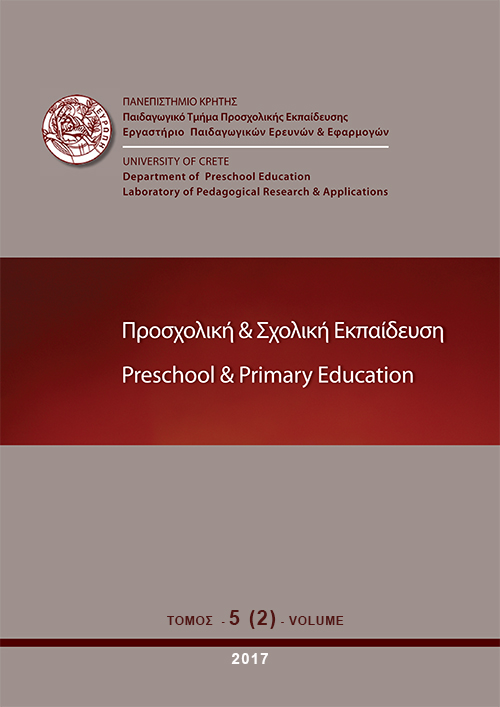Επιλεκτική Αλαλία στο Σχολείο. Σχέσεις και Αντιλήψεις στο Εκπαιδευτικό Πλαίσιο: Μία Μελέτη Περίπτωσης.
Résumé
Η επιλεκτική αλαλία είναι αγχώδης διαταραχή κατά την οποία ένα παιδί δε μιλά σε συγκεκριμένες κοινωνικές περιστάσεις ενώ έχει την ικανότητα να το πράξει. Τα παιδιά με επιλεκτική αλαλία αντιμετωπίζουν δυσκολίες στο σχολείο, παρουσιάζοντας ανεπάρκεια στις γλωσσικές και κοινωνικές δεξιότητες, καθώς και στην δημιουργία φιλικών σχέσεων. Δυσκολίες αντιμετωπίζουν και οι εκπαιδευτικοί που καλούνται να στηρίξουν και να εντάξουν στην εκπαιδευτική διαδικασία ένα τέτοιο παιδί. Σκοπός της παρούσας ποιοτικής έρευνας ήταν να μελετήσει, μέσα στο θεσμικό εκπαιδευτικό πλαίσιο, τη λειτουργία παραμέτρων που συνδιαμορφώνουν τις κοινωνικές και παιδαγωγικές σχέσεις και αλληλεπιδράσεις ενός ενδεκάχρονου παιδιού με επιλεκτική αλαλία. Για τη συλλογή των δεδομένων χρησιμοποιήθηκαν: (α) κοινωνιομετρικό τεστ για τη μέτρηση της δημοτικότητας του μαθητή, (β) ερωτηματολόγια για τη γλωσσική επικοινωνία του μαθητή (το «Selective Mutism Questionnaire» –ερωτηματολόγιο κηδεμόνων- και το «School Speech Questionnaire»– ερωτηματολόγιο εκπαιδευτικών), (γ) ημιδομημένες συνεντεύξεις με κηδεμόνες και εκπαιδευτικούς, και (δ) μη συμμετοχική παρατήρηση του μαθητή στη διάρκεια του διαλείμματος. Σε γενικές γραμμές, τα αποτελέσματα παρουσιάζουν ένα παιδί σιωπηλό και αγνοημένο, ενώ οι εκπαιδευτικοί αισθάνονται ότι δεν διαθέτουν την ανάλογη κατάρτιση ώστε να ανταποκριθούν στις ιδιαίτερες ανάγκες του. Εκτός σχολείου, πρόκειται για ένα παιδί με φίλους με τους οποίους επικοινωνεί λεκτικά. Συνολικά, η έρευνα παρουσιάζει πτυχές της ζωής ενός παιδιού με επιλεκτική αλαλία παραπέμποντας στην ανάγκη συστηματικότερης διερεύνησης των αναγκών και των τρόπων στήριξης στο σχολικό πλαίσιο.
Article Details
- Comment citer
-
Mokaiti, F., Rekalidou, G., & Karousou, A. (2017). Επιλεκτική Αλαλία στο Σχολείο. Σχέσεις και Αντιλήψεις στο Εκπαιδευτικό Πλαίσιο: Μία Μελέτη Περίπτωσης. Preschool and Primary Education, 5(2), 27–64. https://doi.org/10.12681/ppej.11446
- Numéro
- Vol. 5 No 2 (2017)
- Rubrique
- Άρθρα

Ce travail est disponible sous licence Creative Commons Attribution - Pas d’Utilisation Commerciale - Partage dans les Mêmes Conditions 4.0 International.
Οι συγγραφείς των άρθρων που δημοσιεύονται στο ΠΡΟΣΧΟΛΙΚΗ & ΣΧΟΛΙΚΗ ΕΚΠΑΙΔΕΥΣΗ διατηρούν τα δικαιώματα πνευματικής ιδιοκτησίας επί των άρθρων τους, δίνοντας στο περιοδικό το δικαίωμα της πρώτης δημοσίευσης. Άρθρα που δημοσιεύονται στο ΠΡΟΣΧΟΛΙΚΗ & ΣΧΟΛΙΚΗ ΕΚΠΑΙΔΕΥΣΗ διατίθενται με άδεια Creative Commons 3.0 και σύμφωνα με την άδεια μπορούν να χρησιμοποιούνται ελεύθερα, με αναφορά στο/στη συγγραφέα και στην πρώτη δημοσίευση για μη κερδοσκοπικούς σκοπούς και με δικαίωμα τροποποίησης μόνον με παρόμοια διανομή (αν αναμείξετε, τροποποιήσετε, ή δημιουργήσετε πάνω στο υλικό, πρέπει να διανείμετε τις δικές σας συνεισφορές υπό την ίδια άδεια όπως και το πρωτότυπο). To Εργαστήριο Παιδαγωγικών Ερευνών και Εφαρμογών του Παιδαγωγικού Τμήματος Προσχολικής Εκπαίδευσης του Πανεπιστημίου Κρήτης και το Εθνικό Κέντρο Τεκμηρίωσης διατηρούν το δικαίωμα να δημοσιεύουν, να αναπαραγάγουν, να παρουσιάζουν στο κοινό, να διανέμουν και χρησιμοποιούν άρθρα που δημοσιεύονται στο ΠΡΟΣΧΟΛΙΚΗ & ΣΧΟΛΙΚΗ ΕΚΠΑΙΔΕΥΣΗ σε οποιοδήποτε μέσο και μορφή είτε μεμονωμένα είτε ως μέρη συλλογικών έργων, για όλο το χρόνο διάρκειας προστασίας της πνευματικής ιδιοκτησίας και για όλες τις χώρες του κόσμου. Αυτό περιλαμβάνει ενδεικτικά και όχι αποκλειστικά, το δικαίωμα δημοσίευσης των άρθρων σε τεύχη του περιοδικού ΠΡΟΣΧΟΛΙΚΗ & ΣΧΟΛΙΚΗ ΕΚΠΑΙΔΕΥΣΗ, αναπαραγωγής και διανομής μεμονωμένων αντιγράφων των άρθρων, αναπαραγωγής ολόκληρων των άρθρων σε άλλη έκδοση του Εργαστηρίου Παιδαγωγικών Ερευνών και Εφαρμογών του Παιδαγωγικού Τμήματος Προσχολικής Εκπαίδευσης του Πανεπιστημίου Κρήτης και του Εθνικού Κέντρου Τεκμηρίωσης και αναπαραγωγής και διανομής των άρθρων ή περίληψης αυτών με χρήση πληροφορικού συστήματος αποθετηρίου.



